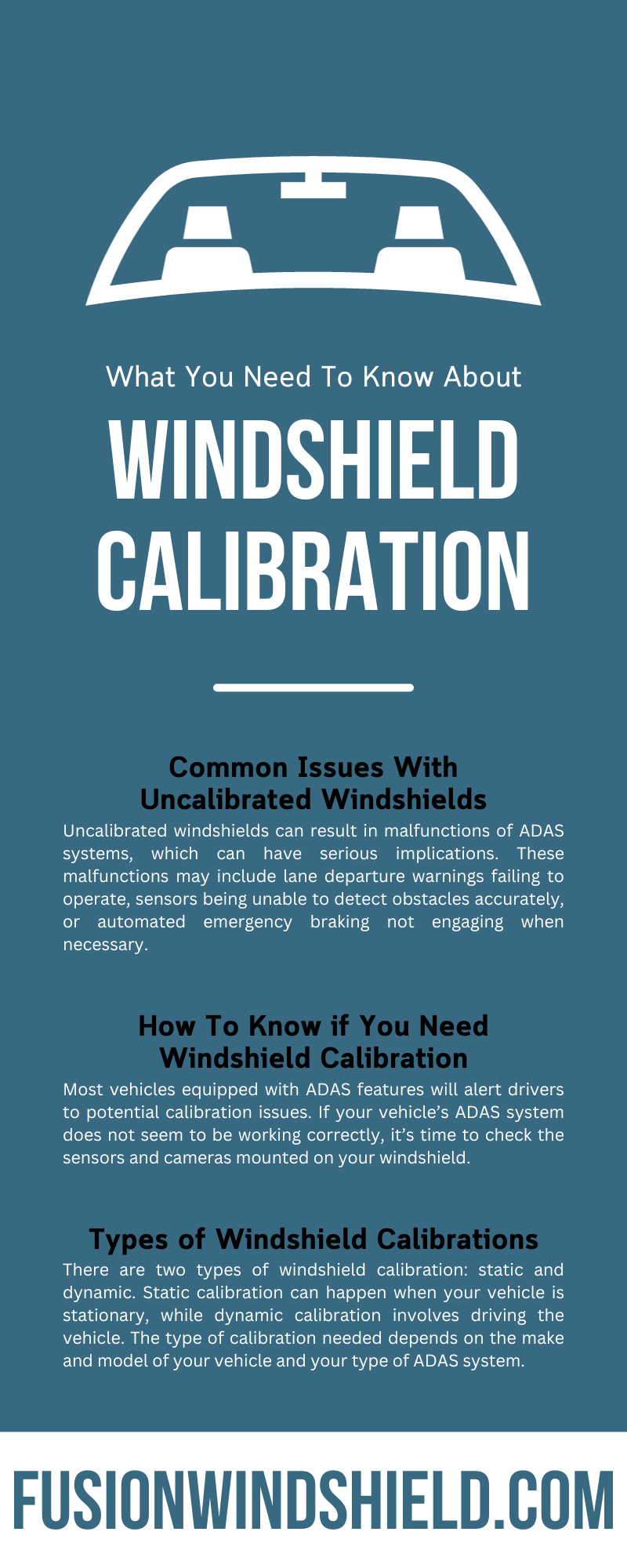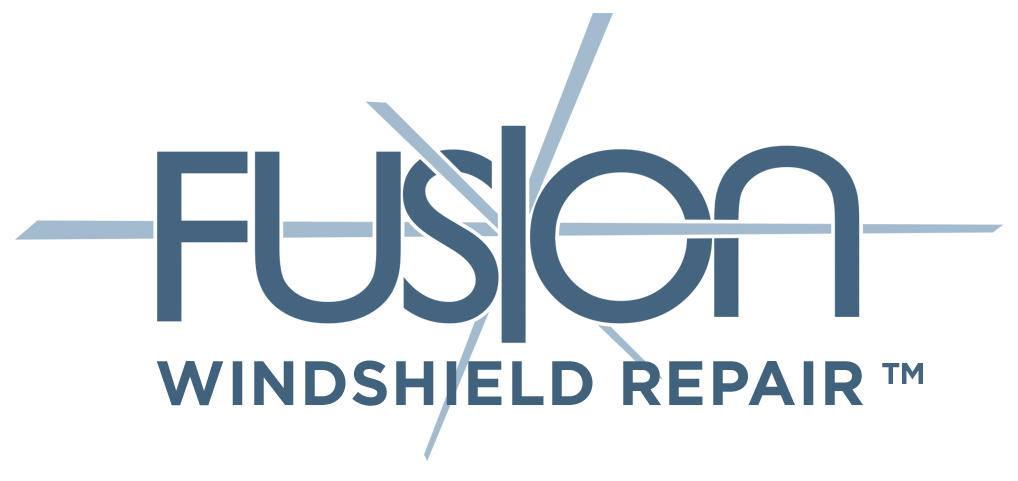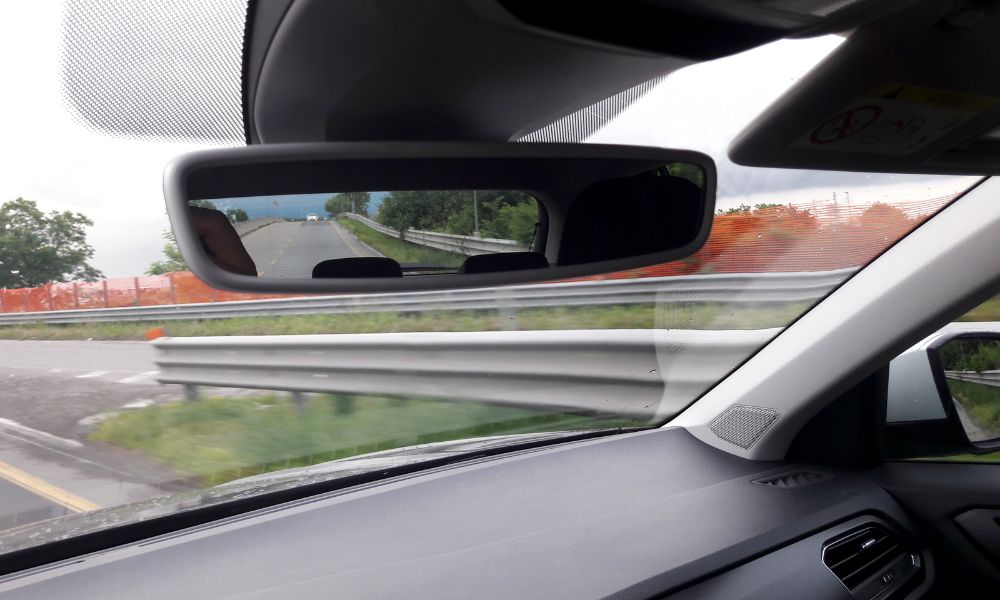Windshield calibration is a part of vehicle maintenance that every driver should be aware of. In this comprehensive guide, we’ll tell you everything you need to know about windshield calibration. We’ll cover what windshield calibration entails, why it is important, and how it impacts the functionality of Advanced Driver Assistance Systems (ADAS). You don’t want to miss this important information!
The Basics of Windshield Calibration
Windshield calibration is a process that ensures the sensors and cameras on your windshield are in the correct positions, allowing your vehicle to detect and respond to traffic and obstacles. Your windshield is the primary location for the sensors and cameras that advanced driver assistance systems (ADAS) use.
These systems include lane departure warnings, collision avoidance sensors, and automated braking. Without proper windshield calibration, these systems may not function effectively, risking the safety of drivers and passengers.
Common Issues With Uncalibrated Windshields
Uncalibrated windshields can result in malfunctions of ADAS systems, which can have serious implications. These malfunctions may include lane departure warnings failing to operate, sensors being unable to detect obstacles accurately, or automated emergency braking not engaging when necessary.
These issues can significantly increase the risk of accidents, leading to vehicle injuries and damage. Therefore, it is crucial to properly calibrate windshields.
How To Know if You Need Windshield Calibration
Most vehicles equipped with ADAS features will alert drivers to potential calibration issues. If your vehicle’s ADAS system does not seem to be working correctly, it’s time to check the sensors and cameras mounted on your windshield. It’s important to have a professional technician check these systems regularly to prevent malfunctions.
Signs of ADAS System Malfunction
Understandably, your ADAS system plays various roles in your vehicle. Look for the following system malfunctions as you operate the vehicle.
- Lane Departure Warning (LDW) not operating correctly
- Collision Warning or Forward Collision Warning (FCW) not providing accurate alerts
- Blind Spot Detection (BSD) system failing to detect vehicles in adjacent lanes
- Adaptive Cruise Control (ACC) not maintaining a safe distance from other vehicles
- Automatic Emergency Braking (AEB) not engaging when necessary
- Traffic Sign Recognition (TSR) failing to detect and display road signs
- Parking Assist systems not functioning properly
- Erratic system behavior or false alarms
Benefits of Windshield Calibration
Windshield calibration offers several benefits for vehicle owners. For starters, it ensures the accurate functioning of Advanced Driver Assistance Systems (ADAS). Through precise calibration, these sensors and cameras work to enhance road safety.
Windshield calibration also helps maintain the optimal performance of the vehicle’s ADAS features. Over time, factors such as road vibrations and windshield replacements can affect the alignment and accuracy of the sensors and cameras. By regularly calibrating the windshield, you can correct inaccuracies.
Furthermore, proper windshield calibration can help prevent false activations and malfunctions of ADAS features. Good systems can distinguish between real obstacles and false signals, reducing the likelihood of unnecessary interventions by the ADAS system. Accurate system decisions minimize distractions caused by false alerts.
Windshield calibration is essential for preserving warranty and insurance coverage for some vehicles. Many insurance companies require windshield recalibration after replacements to ensure the ADAS system functions correctly. Adhering to these rules can avoid potential issues with insurance claims or warranty coverage.
Types of Windshield Calibrations
There are two types of windshield calibration: static and dynamic. Static calibration can happen when your vehicle is stationary, while dynamic calibration involves driving the vehicle. The type of calibration needed depends on the make and model of your vehicle and your type of ADAS system. However, it’s important to understand both methods.
Dynamic Calibration
During dynamic calibration, the vehicle performs calibration while in motion. The ADAS system gathers data and recalibrates itself as you drive the vehicle under specific conditions. Sensors and cameras analyze real-time information to make necessary adjustments for optimal performance.
ADAS features such as lane departure warnings, adaptive cruise control, and automatic emergency braking typically require this type of calibration.
Static Calibration
When calibrating the sensors and cameras mounted on the windshield, technicians perform static calibration while the vehicle remains stationary. This process involves aligning and positioning the components correctly using specialized equipment.
The technician utilizes targets and tools to ensure the precise positioning of these components according to manufacturer specifications. Manufacturers often require static calibration for ADAS features such as forward collision warning, blind-spot detection, and parking assist systems.
Who Can Perform Windshield Calibrations?
It might be tempting to try DIY calibration, but it’s a job vehicle owners should leave to the professionals. Trained technicians equipped with the proper tools and equipment perform windshield calibration. These technicians possess specialized knowledge and experience in working with ADAS systems, meaning they can better achieve proper calibration.
Overview of Performing Windshield Calibrations
Professionals perform windshield calibration using special equipment and following specific procedures. Read through this general overview of procedures to better understand the process.
- Preparation: The technician will park the vehicle. They will also check the vehicle’s battery to prevent any power-related issues during the calibration process.
- Alignment: The technician will carefully position and align the calibration targets or patterns on the vehicle. These targets help the ADAS system accurately adjust and calibrate its sensors and cameras.
- Calibration Equipment: Depending on the vehicle and ADAS system, the technician will use specific calibration equipment, including optical alignment tools, diagnostic scanners, and software interfaces.
- Sensor Calibration: The technician will calibrate the sensors and cameras mounted on the windshield. This process may involve adjusting the camera lens angles, verifying sensor functionality, and aligning the sensors with the vehicle’s geometry.
- Testing: After the calibration, the technician will thoroughly test the ADAS system to ensure proper functionality. They may perform test drives or use simulations to verify that all ADAS features work.
How To Choose the Right Professional
When choosing the right technician for your windshield calibration, look for a professional who has experience with your vehicle’s ADAS system. It is also essential to seek out a professional who values safety and follows proper safety procedures.
You don’t want to put yourself or your passengers at risk by working with someone who does a hasty (and inaccurate job). Furthermore, it’s important to think about convenience. Sometimes, you may need a technician to come to your home, workplace, or other site to perform calibrations. In that case, a professional specializing in mobile windshield calibrations can help you.
How To Maintain Properly Calibrated Windshields
A critical thing you need to know about windshield calibration is maintenance. After all, you want to keep everything intact. Make sure your windshield is free of cracks or chips that could impact the sensors to ensure that your vehicle’s sensors and cameras have the correct alignment. It’s also essential to have regular calibration checks after any auto glass-related work.
While it may seem small, windshield calibration plays a significant role in ensuring your safety and reducing the risk of accidents. By working with the right technician, you can maintain a safer driving experience.



Recent Comments